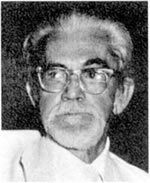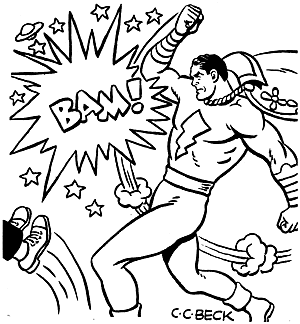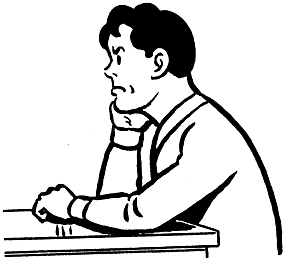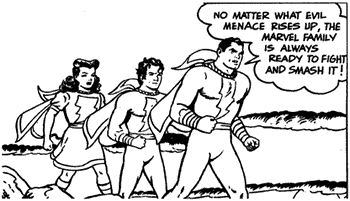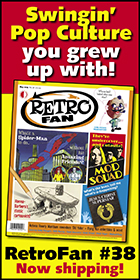- Shop
- Connect
- Customer Service
Shipping
For orders in the USA, we ship by Media Mail from North Carolina, so please allow sufficient time for delivery, especially if you’re on the West Coast.
Please note that US subscription copies are sent by Standard Mail unless you’ve requested the more expensive "First Class" option, and can take from a few days to two weeks or more, depending on the speed of mail delivery in your area. Since we have no control over the US Postal Service’s delivery speed, if getting your magazine before it appears in stores is critical to you, we suggest you select our "First Class" option, or purchase our magazines at your local comics shop.
For international orders, First Class Mail International (only available for packages weighing up to 4 lbs.) usually takes 2-4 weeks. Priority Mail International usually takes 1-2 weeks. Flat Rate shipping usually takes 6-8 weeks (it goes by "Surface" and the minimum charge is for 11 lbs., making it economical only for larger orders). For packages of 4 lbs. or less, the "First Class Mail International" option will generally cost less, and have faster delivery. If you want a larger package (over 4 lbs.) in the quickest time possible, your only option is the more expensive "Priority Mail International".
NOTE FOR PRIORITY MAIL CUSTOMERS: If your order contains a combination of items that are currently shipping, and upcoming items (i.e. ones that aren’t shipping yet), and you choose Priority Mail (or Priority Mail International) as your shipping option, we will send the currently shipping items by Priority Mail, then send the upcoming items by the least expensive way possible as they become available. If you want the upcoming items to also ship by Priority Mail, you’ll need to put each upcoming item on a separate order, so our web store can calculate the additional Priority Mail shipping costs for them.
Thanks for supporting TwoMorrows Publishing!Shop with Confidence

If you are unhappy with the condition of an item you received, or were sent an item you didn’t order (or are missing an item you did order), please contact us at 919-449-0344 or e-mail to twomorrow@aol.com and we’ll do everything possible to correct the problem.
Welcome to our Store!
In 1989, my wife Pamela and I started TwoMorrows Advertising in Raleigh, North Carolina, providing advertising and graphic design services to local and national accounts. ("TwoMorrows" is a play on our last name-there’s two of us!) In early 1994, after hearing of Jack Kirby’s death, I (being a lifelong Kirby fan) dug out my Kirby comics and, after spending that Spring re-experiencing what had drawn me to Kirby’s work originally, decided to produce a newsletter about him in my spare time. The result was THE JACK KIRBY COLLECTOR #1 in September 1994, mailed free to 125 other Kirby fans.
TJKC quickly caught on, and things snowballed from there. In 1998, we teamed with editor Jon B. Cooke to produce the Eisner Award-winning Comic Book Artist, followed by the revival of Roy Thomas’ 1960s fanzine Alter Ego in 1999 (another Eisner Award winner for us). Mike Manley’s DRAW! (the professional how-to magazine about comics, cartooning, and animation) debuted in 2001, and Danny Fingeroth’s WRITE NOW! (offering tips and lessons on writing for comics) premiered in 2002. In 2004, we launched BACK ISSUE! magazine (edited by Michael Eury), covering comics of the 1970s, ’80s, and today, and in 2006, we spun the ROUGH STUFF section of BACK ISSUE! into its own magazine (edited by Bob McLeod), celebrating the art of creating comics. In 2008, we launched BRICKJOURNAL, the ultimate magazine for LEGO enthusiasts. And Jon B. Cooke has returned to TwoMorrows in 2013 with the launch of COMIC BOOK CREATOR, the new voice of the comics medium.
In addition, we publish a line of highly respected and award-winning trade paperbacks, encompassing a wide variety of interests. But regardless of what time period or genre we cover, we always try to provide our readers what they want: in-depth coverage of comics (and LEGO!) history and creators, with a fun, positive slant, in the most professional manner possible.
Since 1994, we’ve been showing fans the future of comics (and now LEGO®) history. Sample any of our publications, and join the revolution!
John Morrow, publisher

Alter Ego 7 - The Marvel Family Battles Evil IncarnateThe Marvel Family Battles Evil IncarnateThe Final Showdown Between C.C. Beck and DC Comicsby P.C. Hamerlinck & Roy Thomas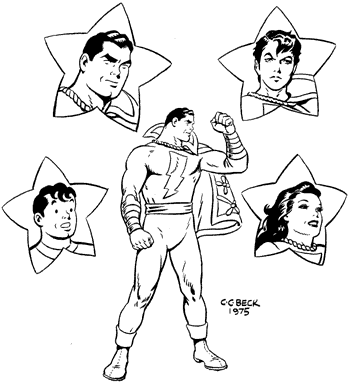 The Marvel Family-a 1975 convention drawing by C.C. Beck. [Characters ©2001 DC Comics; art ©2001 estate of C.C. Beck.] C.C. Beck needs no introduction. In 1940 Beck's clean and simple artwork brought Fawcett Comics' Captain Marvel to life and changed the course of comics history. The magic ended in 1953; the wisdom of Solomon told Fawcett that comic books weren't as lucrative a business as they used to be. In addition, Fawcett, disgusted by the never-ending litigation with Superman's publisher which had brought suit against them, decided to fold their entire line of comic books. Captain Marvel and The Marvel Family faded into oblivion. Twenty years later, DC Comics, the very company whose attorneys had campaigned in the courtroom to kill Captain Marvel, were reviving him in a new comic book called Shazam! C.C. Beck, after being asked to submit samples (!), came on board as the artist for the revival. Beck quickly became dismayed at the poor scripts he was asked to illustrate. He clashed often with editor Julius Schwartz. Everything came to a screeching halt when Beck refused to illustrate two stories slated for Shazam! #11 - stories that he called "worthless" - involving Captain Marvel eating gelatin and talking to Santa Claus. [EDITOR'S NOTE: For more details, read "Can Lightning Strike Twice?" from Comic Book Artist #1, reprinted in Comic Book Artist Collection - Volume 1.]
In 1974, after Beck had stopped drawing for DC, editor E. Nelson Bridwell extended him an invitation, informing him that if he wanted to submit a script, and if it was approved by the editorial staff, they would let him draw it up. Beck immediately wrote and sent in a Marvel Family script called "Captain Marvel Battles Evil Incarnate." The story opens with Captain Marvel catching some thieves at a warehouse. He turns them over to the police, saying he will appear to testify at the trial. He turns into Billy Batson and finds himself in the underground hall of statues of the Seven Deadly Enemies of Man.
Shazam appears and tells Billy that, though the bodies of the seven evil spirits are imprisoned in the statues, they still roam the Earth and are plotting new revenge. (A flashback sequence shows Captain Marvel fighting the seven evil spirits in previous stories.) As nothing new in the way of evil seems to be happening yet, Billy goes home to bed, somewhat worried. While Billy sleeps, the evil seven are holding a meeting and discussing ways to get rid of Captain Marvel. A witch appears and says that magic may work against him. She puts an evil spell on a picture, which is given to Billy as a present for Captain Marvel. Billy puts it on his desk and the spell starts working. As he reads the paper, he sees that the warehouse thieves have been released from jail by a criminal lawyer, who happens to be one of the evil seven. Billy loses his temper. He turns on the radio and hears another member of the evil seven saying that Captain Marvel doesn't even exist. Billy changes into Marvel and confronts the two, who run away. He finds another of the evil seven threatening to foreclose on Station WHIZ, which he is helpless to prevent. Captain Marvel now begins to see how the forces of evil are working against him and is so frustrated that he punches a hole in the wall in anger. He is starting to crack up. He gets so mad that he tears up the picture, thus removing the spell that was on him and Billy, although neither of them knew this. The evil seven summon up a horrible demon named Odius and send him off to destroy Captain Marvel. A tremendous fight takes place, the demon is knocked through a window, and Marvel changes to Billy. But Odius comes back and puts a curse on Billy so that he becomes evil. Billy destroys his poster of Captain Marvel and says, "Never mention his name to me! I hate, despise, and loathe him!" The evil seven walk into the Station WHIZ offices, each with an attendant spirit hovering over him. They throw WHIZ president Sterling Morris out, take over the station, and demote Billy to errand boy and garbage handler. All seems lost, but Uncle Marvel sends Mary Marvel and Captain Marvel Jr. to get Billy. They have to knock him out before they bring him back, as Billy is now completely evil. Uncle revives Billy and tricks him into saying "Shazam!" The curse on Billy is broken when Captain Marvel appears, and The Marvel Family fly back toward Station WHIZ. The evil seven see The Marvel Family coming and try to summon Odius again, but he refuses to appear. Seeing that they are all helpless, the seven evil spirits depart from the bodies they took over and they are left to the mercy of the Marvels. At the end Captain Marvel says to Mary and Junior, "I guess you could say that they lost their spirits when it came to a showdown." That was Beck's story. It had, he thought, all the old mystery, magic, and evil forces of the old stories, and showed how Captain Marvel was almost defeated when the evil seven spirits teamed up against him. Six months passed after Beck wrote and sent in his script to DC, with no response from them. Finally, waiting in his mailbox was an envelope from DC. E. Nelson Bridwell had returned Beck's script to him, severely edited and rewritten. Here's Beck's story after Bridwell edited it and sent it back to Beck to draw: A dramatic splash page contains Captain Marvel facing Odius. The story doesn't begin until page two, with Captain Marvel catching crooks and the police taking them away. Marvel changes to Billy and goes to the hall of statues. Shazam appears and tells a long story of how, as a young man six thousand years ago, he first defeated the seven evil spirits and turned them to stone with his "white magic." Shazam gives Billy a solemn warning, then fades away. Billy yawns and goes home to "hit the sack." The evil seven put a "dream inducer," a little gadget they have "stolen from a scientist," into the frame of a picture which they send to Billy. Nothing happens the rest of the day; Billy goes home, taking the picture with him, and again "hits the sack." He has a nightmare and screams. Pa Potter comes in to wake him up, and Billy's nightmare monsters come right out of his dream and attack Pa, causing him to fall out of the window. Billy, still asleep, sees this in his dream, changes to Captain Marvel, and flies to Pa's rescue. Marvel then tears open the picture frame, squashes the gadget, and says, "A gadget that creates nightmares could drive a person mad!" All is quiet for the next few days, until the evil seven summon the demon Odius and send him to fight Captain Marvel. This portion of the story is as Beck wrote it, but after the curse is put on Billy he bawls out his boss Mr. Morris and refuses to say "Shazam!"
A "crime wave" now begins, and Uncle Marvel sends Mary Marvel and Captain Marvel Jr. to stop it. Odius is still lurking around when he suddenly waves his hand, casting a "hate the Marvels" hex into the people on the streets. The crowd of people become irate and start shouting, "Boo!" A riot breaks out and the crowd begin throwing things at a bewildered Mary and Junior. Meanwhile, Uncle Marvel has gone to Station WHIZ, where he tricks Billy into saying "Shazam!" Captain Marvel appears and, with Uncle clinging to his leg, flies to help Mary and Junior. Marvel sees Odius, immediately figures out exactly what is going on, punches Odius, and everything becomes just dandy. The Marvel Family clean up the "crime wave" and then fly off to finish the evil seven, who haven't been doing anything except just sitting in their meeting room. How The Marvel Family even knew they were alive or where they were located is not explained. The story ends with Billy saying to the reader, "That's how it happened, folks! Just remember, those seven deadly enemies are still around. Don't let them warp your minds, too! Be on guard! So long, and be good!" Understandably, Beck was reluctant to draw the Bridwell-edited story. He felt that it was childish and totally lacking in plot, with too many characters, holes, and loose ends. The evil seven barely appeared. There were unnecessary riot scenes, an unexplained crime wave, unidentified crooks, the addition of a "dream inducer," and Mary Marvel and Captain Marvel Jr. flying around looking helpless. Beck tried to draw the rewritten script, but when he came to illustrate the scene where Uncle Marvel is clinging onto Captain Marvel's leg, he tore up the whole story and threw it in the garbage. Beck returned the rewritten script to DC and told them that he wanted nothing to do with it. DC's invitations to Beck stopped and they never contacted him again.
Perhaps had there been only minimal changes made by Bridwell to Beck's script, Marvel Family and Beck fans would have been treated to an exciting tale filled with Golden Age storytelling elements, written and illustrated by one of the masters of the medium. But the Golden Age was long over. Captain Marvel had become quaint and out of place in the modern world, and his revival was a failure. The Marvel Family were now dim figures from far back in the mist of time. The magic lightning that once boomed from the skies was silent. |
 >
>
 Become a Fan
Become a Fan Follow Us
Follow Us Subscribe
Subscribe Our Blog
Our Blog
